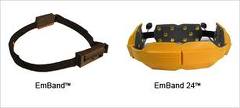Over the decades marketing has become more and more targeted with new and innovative ways to determine consumer engagement with advertisements. The EmBand and the EmBand 24 are no exceptions. These tools were released just a month ago by the EmSense Corporation and are the most advanced “line of neuromeasurement devices for non-invasive physiological and brainwave analysis specifically for market research.” In other words, they are headsets that measure a participant’s brain signals when he or she is watching advertisements on either a television or computer screen. Additionally, the EmBand and EmBand 24 analyze respiration patterns, eye blinks, head movement, body temperature and changes in heart rates. When all of this data is combined, researchers can establish the cognitive and emotional responses a person has to specific advertisements, which in turn might help marketers create more successful ads.
EmSense Corporation and are the most advanced “line of neuromeasurement devices for non-invasive physiological and brainwave analysis specifically for market research.” In other words, they are headsets that measure a participant’s brain signals when he or she is watching advertisements on either a television or computer screen. Additionally, the EmBand and EmBand 24 analyze respiration patterns, eye blinks, head movement, body temperature and changes in heart rates. When all of this data is combined, researchers can establish the cognitive and emotional responses a person has to specific advertisements, which in turn might help marketers create more successful ads.
Although similar devices have been created in the past, the EmBand and Emband 24 far surpass their EEG predecessors because they are less meddlesome. They do not require gel electrodes, are quick and easy to set up, lack additional obtrusive attachments, allow for full participant mobility and are more comfortable. Most importantly, they are a more reasonable price. But, despite their potential value for researchers, I wonder if it might be taking things a step too far. Are advertisers becoming too intrusive by looking into our personal thoughts? Other, more traditional methods for researching audiences rely on participants willingly providing information usually via surveys, but with the EmBand, no one can control the input their brain activities reveal.
So far, the apparatuses have tested more than 100,000 participants in 25 countries so it is already off to a quick start. While it solely depends on the participation of volunteers at the moment, it is uncertain how far this technology will go in the coming years or how the Emband and EmBand 24 will transform marketing. Would you volunteer your brain and body for this new tool?


3 Responses to Is Marketing Becoming Too Invasive?